ARA Veinticinco de Mayo: Along the line of the Chilean-Argentinian Naval Arms race, the “25 of May” (national holiday, revolution) was a brand new 3,500 tons protected cruiser built in UK under President Miguel Juárez Celman for £260,000 at the Armstrong, yards. Named ARA Necochea at first, then 25 of May, she was roughly a repeat of the well-balanced Piemonte made for the Regia Marina. Fast and well armed with two 210 mm (8-in), four 120 mm (4.7 in) QF guns per side, 24 smaller guns, six torpedo tubes, and even two steam boats with spar torpedoes, she sure was versatile and hard hitting. She became a school ship in 1916 and and was discarded in 1928. She was the 10th of the name, and succeeded by an Italian-built cruiser in the interwar. #ww1 #armadadeargentina #argentiniannavy #cruiser #25demayo
⚙ The naval Arms Race | |
 Armada de Argentina Armada de Argentina |  Armada de Chile Armada de Chile |
| Libertad class (BB) 1887 Veinticinco de Mayo (PC) 1890 Nueve de Julio (PC) 1891 Buenos Aires (PC) 1894 Garibaldi (AC) 1895 San Martín (AC) 1896 Pueyrredón (AC) 1897 General Belgrano (AC) 1898 Rivadavia, Moreno* (AC) 1901 |
Capitán Prat (BB*) 1887 Presidente Errázuriz (PC) 1887 Presidente Pinto (PC) 1887 Blanco Encalada (PC) 1892 Esmeralda (AC) 1894 Ministro Zenteno (PC) 1894 O'Higgins (AC) 1896 Constitución class (BB) 1901 Chacabuco (PC) 1901 |
Design Genesis and Order
In 1890, the Argentine government headed by President Miguel Juárez Celman decided to purchase a new cruiser in the context of high tension with Chile, border disputes regarding the application of the 1881 Treaty. The Argentine representative to the United Kingdom, Dr. Luis L. Domínguez reported a good design worth purchasing, and signed a contract for £260,000 (1,310,410 m$n gold) with W. Armstrong, Michel & Co., in Newcastle-on-Tyne. It specified a 3,500-tonne protected cruiser. Her initial contract name, “Necochea” was prehaps a ruse to confuse Chilean observers in UK since the name was almost never use was was not reflective of a large warship. What Dominguez reported was the Yard just built a well-balanced, powerful protected cruiser design for Italy (piemonte launched in 1888) and in the addition of reduced design costs, it would bring to the Armada a brand new, powerful cruiser way more capable than those of Chile at the time, the two Presidente Pinto we already seen.
Before finalizing construction, it was decided to change the name “25 de Mayo” and so she was launched on March 5, 1890. First commander became Captain Ceferino Ramírez, until then assisting Dominguez in UK and now put in charge of controlling her completion in Britain.
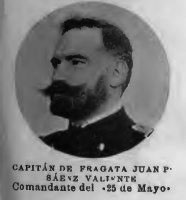
ARA Veinticinco de Mayo was thus a steam-powered protected cruiser very similar to Piemonte, albeit improved and larger as shown by the differences highlighted below.
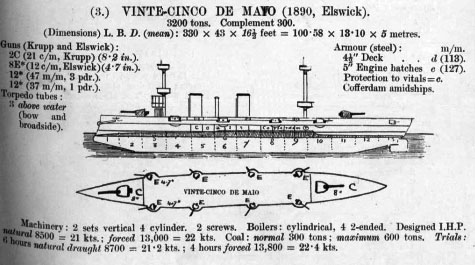
Design of the class
Hull and general design
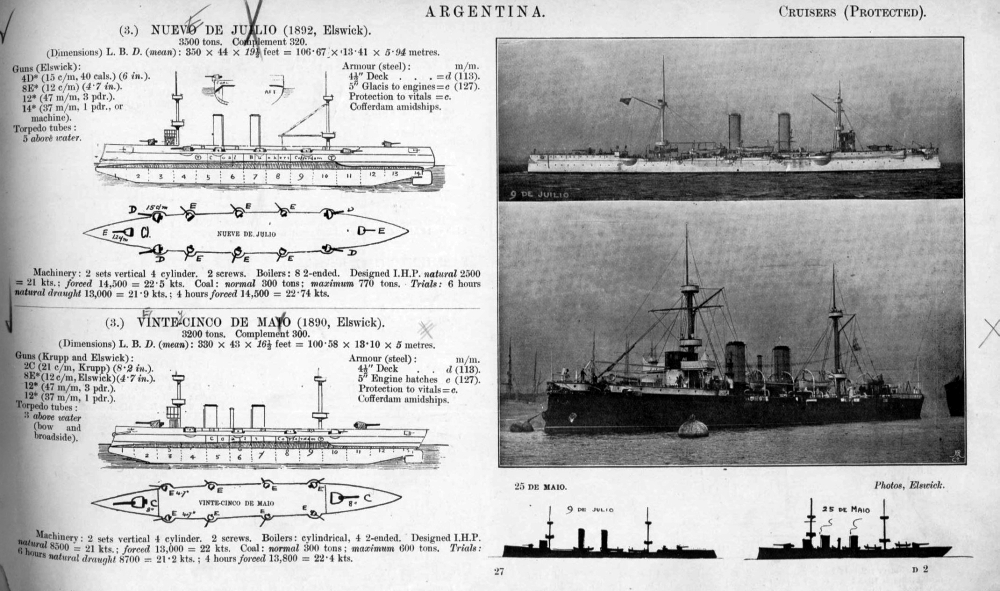
Brassey’s page comparing the 9 de Julio and 25 de Mayo.
Its steel hull had a ram in the bow, and was protected with an armored deck. The proposed design of a modified Piemonte type built for the Italian Navy was improved for the Argentinians. The ship was slightly larger, with a steel hull and ram, 120 mm armor belt and turtleback armor deck of 25-27 mm. At 107.90 m long for 13.41 m in beam and 7.92 m of draft (average draft 5.95 m). She also was larger. Piemonte indeed was “only” 2,473 long tons (2,513 t) in displacement versus 3,180 tonnes standard and 3,500 tonnes fully loaded and measured 310 x 38 x 15ft (94.5 x 11.6 x 4.6 m).
The general design was typical of the time, she was symmetrical, with a forecastle and poop deck (and clipper poop), two similar military masts, two heavenly spaced funnels and a quantity of air intakes. All service boats (8) were under davits on this central section amidship. A bridge was constructed atop the Conning Tower, which was placed in front of the foremast. Photos however shows she had no bridge at all when in sea trials. It was added later, at first a small wooden structure, and then a painted, more military one.
In general she is often compared to the 1892 (same yard, Eslwick) ARA 9 de Julio. In fact Jane’s 1910 (above) place them in the same page for easier comparison. Both had roughly the same design, but armaments, size, displacement changes making them two different animals worthy of separate treatment.
Armour protection layout
It was limited to a 120 mm (4.7 inches) armour belt, completed by the armoured deck, turtledeck shaped as usual for the time, with side slopes going from 25 to 27 mm (0.98–1.06 in) on the sloped section. It seems the Gun shields and Conning Tower forward were also protected by 25 mm armor. There was a compartimentation for ASW protection, she had 13 separate compartments underwater protected by bulkheads but no double bottom.
Powerplant
Like the Piemonte however she was propelled by two 4-cylinders vertical triple-expansion machines (VTE), fed by four cylindrical boilers. But this diverged by their total output of 8,500 HP (versus
four Scotch marine boilers and an output of 12,000 ihp on Piemonte). The shafts drove two Humpreys Tenant Co. propellers, enabling 25 de Mayo to reach 22 knots, with a cruising speed of 11 knots. Thus was comparable to Piemonte, but she had less range. With only 639 t of coal aboard in normal condition this only ensured a range of 5,025 miles versus 7,000 nautical miles (13,000 km; 8,100 mi) at 10 knots (19 km/h; 12 mph) for Piemonte.
Armament
25 de Mayo’s main battery was centered around two Vickers Armstrong 210 millimetres (8.2 in) guns forward and aft, four rapid fire sponsoned 124 mm (4.8-in) guns per side.
The secondary battery comprised no less than twelve 47 mm (6-pdr) Hotchkiss guns and twelve 37mm (3-pdr) also quick-fire (QF) Hotchkiss guns.
The twelve 6-pdr were located on deck on either side, then four more in hull recesses, casemates fore and aft, and the remainder four on deck.
The twelve 3-pdr were located on deck, and on the fore and aft bridges wings.
She had two military masts with fighting tops in which eight Maxim machine guns were located.
Initially she was to have only three torpedo tubes, but this was later increased to six.
Cherry on the cake, she also had space large enough close to the mainmast to store two fast steam cutters equipped with spar torpedoes, to act as impromptu torpedo boats in anchorage and bays. Chile indeed in 1891 made the experience first hand of having in its civil war its flagship armoured frigate sunk by a torpedo ship. But earlier, the French managed to sink the Chinese Frigate Yuyuang of the Nanchang fleet with two small spar torpedo steam cutters at the battle of Shipu in 1885, adding to previous success at Fu-Cheou with dedicated TBs. This was also noted by many admiralties round the world.
In appearance, 25 de Mayo changed a lot during her career. As built she was painted with the typical livery of the time: Black hull above water, dark red hull underwater, structures in canvas sand color and some parts in white. Wooden decks for the forcastle, poop deck and main battery deck. From her refit in 1894, she received a new paint, with the hull in white (including the bridge), but structures still in canvas sand.
It seems from 1895 her funnels and masts were painted black. The mainmast aft was shortened compared to the foremast, wire telegraphy was installed. A 1896 painting shows a return to sand canvas for superstructures, and equal height, shortened military masts. She kept this livery up to WW1 apparently. There are few photos of her state at the time.
⚙ specifications |
|
| Displacement | 3,500 tons |
| Dimensions | 107.90 x 13.41 x 4.87 m (354 x 44 x 16 ft) |
| Propulsion | 2-shaft VTE, 4 cyl. boilers, 8,500 ihp |
| Speed | 21 knots (24 mph; 39 km/h) |
| Range | 300 to 600 tons coal, 5,025 nautical miles |
| Armament | 2× 210mm (8 in), 8× 124 mm (4.9 in) QF, 12× 47mm Hotchkiss, 12 × 37mm, 8 Maxim MGs, 6× 18 in (460 mm) TTs |
| Protection | Deck 25–27 mm (0.98–1.06 in), Glacis, Gun shields, CT, Belt 120 mm (4.7 in) |
| Crew | 344 |
Veinteicinco de Mayo’s Career 1892-1921
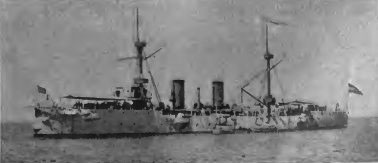
On November 24, 1890, she performed her sea trials on the Tyne and peaked at 22.34 knots. On May 17, 1891 she was commissioned, the Argentinian flag was riased during a ceremony in Britain. On July 29, after preparatons for her first crossing and shakedown cruise, she sailed out under command of captain Ceferino Ramírez with only 83 men for her crew (mostly for the machinery) and she arrived by August 27 1891 at Buenos Aires after a stopover in Portland, USA, but also Las Palmas, São Vicente and Rio de Janeiro. The local revolution was finished.
On September 3, under command of frigate captain Martín Rivadavia, she joined the high seas squadron for a naval review for president Carlos Pellegrini, his national cabinet, and provincial authorities all on the transport Villarino. 25 de Mayo was posted on the roadstead until December, then she was tasked to repress illegal commercial activities on the Patagonian coast. In compliance with it, she captured the guano vessels Gobernador Basavilbaso (lugger), Palmira Criollo and Rosa de Rose (pailebotes), sent to Buenos Aires for internemtn with a small guarding military crew. Later the Uruguayan pailebote Sirio which illegaly hunted sea lions in Argentinian southern waters. They were taken care of by Customs and a part of the prize was delivered to the captain and his crew.
In 1892, 25 de Mayo returned to the Río de la Plata but did not participated in squadron exercizes. In May she sailed to Montevideo with the remains aboard of Pico, and on July 6, she joined Almirante Brown and the torpedo-boat ARA Rosales in the division under Admiral Daniel de Solier to represent Argentina in Spain for the celebrations of the 400th anniversary of the Discovery of America.
A strong storm hit Rosales underway however. The cruiser May 25 and Brown weathered the storm and entered Bahía in Brazil, stopped at San Vicente and arrived in Cádiz on August 2, then Huelva on August 3 to escort a replica of the caravel Santa María, saluted by cannon shots (with the rest of the international squadron).
Next, the squadron joined festivities in Genoa after a stopover in Toulon, where the cruiser was to enter dry dock for maintenance, but since a cholera epidemic affected Marseilles at the time it was decided to continue to Genoa, arriving by September 7, and entering La Spezia Yard instead.
On November 15, second in command Lieutenant Lorenzo M. Irigaray assumed command when the captain was ashore. On December 7, the cruiser was back to San Vicente, meeting ARA Punta Piedras, and arrived in Rio de Janeiro on December 30. On January 4, 1893, she entered Buenos Aires.
On May 7, 1893, frigate captain Atilio S. Barilari took command and the ship stayed neutral during the “radical revolution” as she was under repairs at Cibils dam, Montevideo. By November she returned to the roadstead.
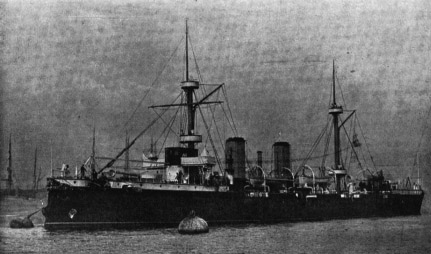
In 1894, she was assigned to the 2nd Division. In August, she repatriated from Montevideo th remains of Nicolás Rodríguez Peña. Until September she participated in squadron maneuvers in Uruguayan waters. Soon after, with a war looming between the Japanese and Chinese, the Chinese government proposed to acquire the Argentinian cruiser, which was politely rejected.
In 1895, 25 de Mayo joined the instruction squadron and sailed with cadets (4th year) of the Naval Military College to Cape Town in South Africa. In April-May she stayed in Montevideo and moved to La Plata bay and Dársena Sur. By December Captain Emilio V. Barilari took command. The cruiser was then placed in reserve for the first time, in Río Santiago.
In 1896, she reintegrated the newly formed 1st Division made also of the cruiser 9 de Julio, Libertad, Patria and Admiral Brown. After passing by Mar del Plata and Puerto Belgrano, she arrived at Golfo Nuevo on January 13. She test fired her torpedoes, and made intensive gunnery drills, plus sent a landing party. She was back in Buenos Aires on February 11.
She was later under command of Manuel Barraza and Hipólito Oliva and joined the instruction squadron making a sortie with ARA Patagonia and Alirante Brown to Rio de Janeiro until October 23.
In 1897 she returned to the 1st Division and alternated with the Instruction Squadron, with common manoeuvers by November. In 1898 under Oliva and Irigaray she went on with the southern Division in February-April and alternated with the Río de la Plata Division, making a naval review off Punta Arena in October.
By February-March 1899 she sailed to Ushuaia and returned to Río Santiago for partial reserve (and partially disarmed). On January 15, 1900, Captain Alfonso M. Díaz took command, she was rearmed and attached to the Cruiser Division. In 1901 under Juan Pablo Sáenz Valiente she cruised to Río Gallegos after incidents in the Seno de Última Esperanza, the Chilean government being transferred to the cruiser Esmeralda. She planted beacons at her return in Bahía San Blas until August 3, the returned to the reserve in Río Santiago (under Enrique Thorne).
In 1902 under Florencio Donovan, she joined the 2nd Division and returned to Río Santiago with a reduced crew for the Instruction Division until May 1903, partially disarmed then under Manuel Lagos. In 1904 under Ernesto Anabia she stays with the Instruction Division until it was disbanded in May. Second Lt. José V. Luisione took command of the cruiser and in June she sailed with the Sailor Apprentice School. This was repeated in 1905 under Ernesto Anabia.
Until March 5, 1906, Lt. Carlos García Aparicio was in command, then Diogenes Aguirre. In August she joined the new Instruction Division with ARA Libertad, Patria and Independencia, fully rearmed. On October 20, she sailed to Valparaíso to escort the president, and repatriate the remains of General Juan Gregorio de Las Heras. In December the Training Division was disbaned again. 25 de Mayo was undergoing an overhaul under command of Enrique G.Plate.
In 1907 the Sailor Apprentice School was still aboard under Julián Irizar, Guillermo Jones Brown and José Quiroga Furque. In 1908 she joined the 2nd Division under Tomás Zurueta until June 10, partially disarmed, and was used by the Artillery Apprentice School. During boats manoeuvers she had two accidental death, a sea corporal and conscript.
In March 1909 under Tomás Zurueta, she was fully rearmed and joined the 2nd Division. On May 1, Luis A. Lan took command for maneuvers in the South Atlantic until June. Dhe was awarded the first prize for accuracy during gunnery drills. Commander Virgiliano Moreno Vera took command later when partially disarmed again, then Mariano Beascochea.
In 1910 for the Centenary of May Revolution, she returned to the 2nd Division but acted independently, cruising from La Plata roadstead to San Blas, stopping also to Toba Island, Oso Marino, Año Nuevo, Isla de States, Ushuaia, Cape Horn and Puerto Madryn. She attended the Centennial festivities and returned to Río Santiago.
1911 saw her staying in place under captain Francisco Lami, but providing sanitary control during an outbreak in Río de la Plata.
In 1912 she was back with the 2nd Division under Jorge Goulú, and later Captain Guillermo Jurgensen until January 1913 and Carlos Miranda. On July 2, 1913 XO Lt.Wenceslao Calero took command and she started a cruise with cadets from the Naval School, with the old battleship Almirante Brown made along the Atlantic coast, with ports visits. It was a mere months before the start of WWI.
In December 1913, Commander Powhatan Page assumed command and she was tasked to train personnel assigned to the newly built battleship ARA Moreno, under completion. On July 13, 1914, Commander Alberto Moreno assumed command and the cruise stayed with Training Division, and in 1915, under Alberto Renard, the Training Division was disbanded. She was disarmed. She later made training trips in the Río de la Plata and ended in the roadstead of Buenos Aires, tasked to enforcing neutrality patrols in wartime. Argentinia staying neutral.
On January 2, 1916, Jorge I.Cross took command, and she spent the whole year at anchor on the same spot. After an inspection of the hull on December 21, 1916, it was decided to transfer her to Río Santiago and convert her as “permanent school ship for junior personnel”. Arrangements were made and internal modifications to host the new personal, but also reduced crew and instructors.
She spent the remaining years of the war and until 1921 in this fashion, immobilized, until stricken and disarmed completely. By 1921 she was reduced to a collier pontoon without military crew. she remained listed as such until 1927/28, and was scrapped in between.
Read More
Books
Gardiner, Robert, ed. (1979). Conway’s All the World’s Fighting Ships 1860–1905.
Caillet-Bois, Teodoro (1944). Historia Naval Argentina (in Spanish). Imprenta López.
Arguindeguy, Pablo E.; Rodríguez, Horacio (1999). Buques de la Armada Argentina 1852-1899 sus comandos y operaciones. Instituto Nacional Browniano.
Burzio, Humberto (1960). Armada Nacional (in Spanish). Secretaria de Estado de Marina.
Piccirilli, Ricardo; Gianello, Leoncio (1963). Biografías navales (in Spanish). Buenos Aires: Secretaría de Estado de Marina.
Arguindeguy, Pablo (1972). Apuntes sobre los buques de la Armada Argentina (1810-1970). Comando en Jefe de la Armada.
Brook, Peter (1999). Warships for Export: Armstrong Warships 1867 – 1927. World Ship Society.
Links
histarmar.com.ar Crucero 25 de Mayo
on en.wikipedia.org
on navypedia.org/

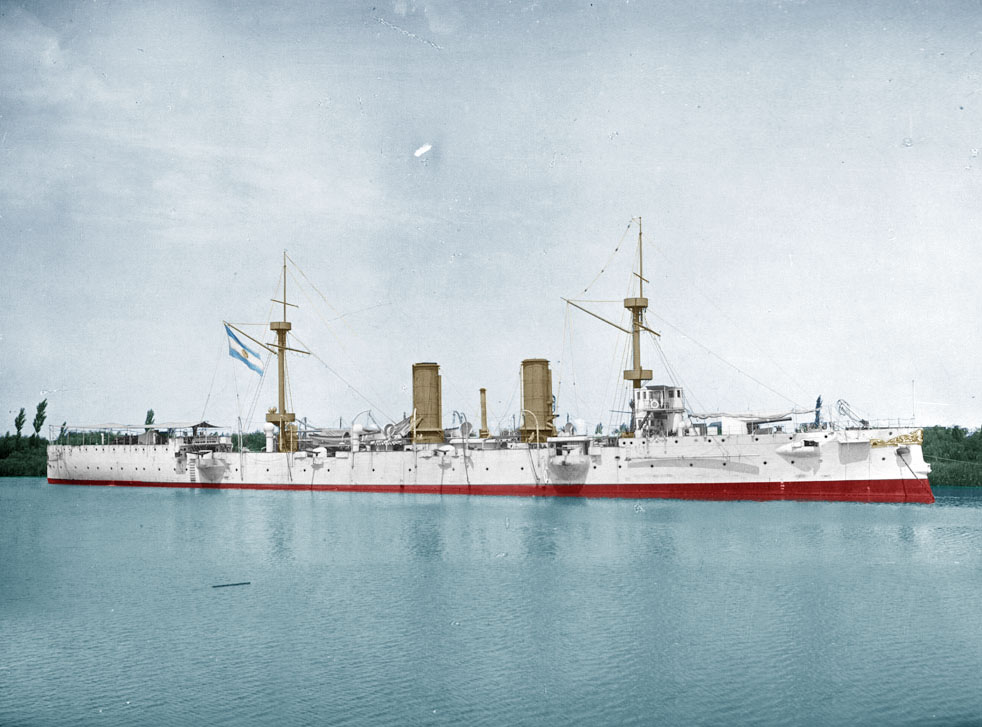

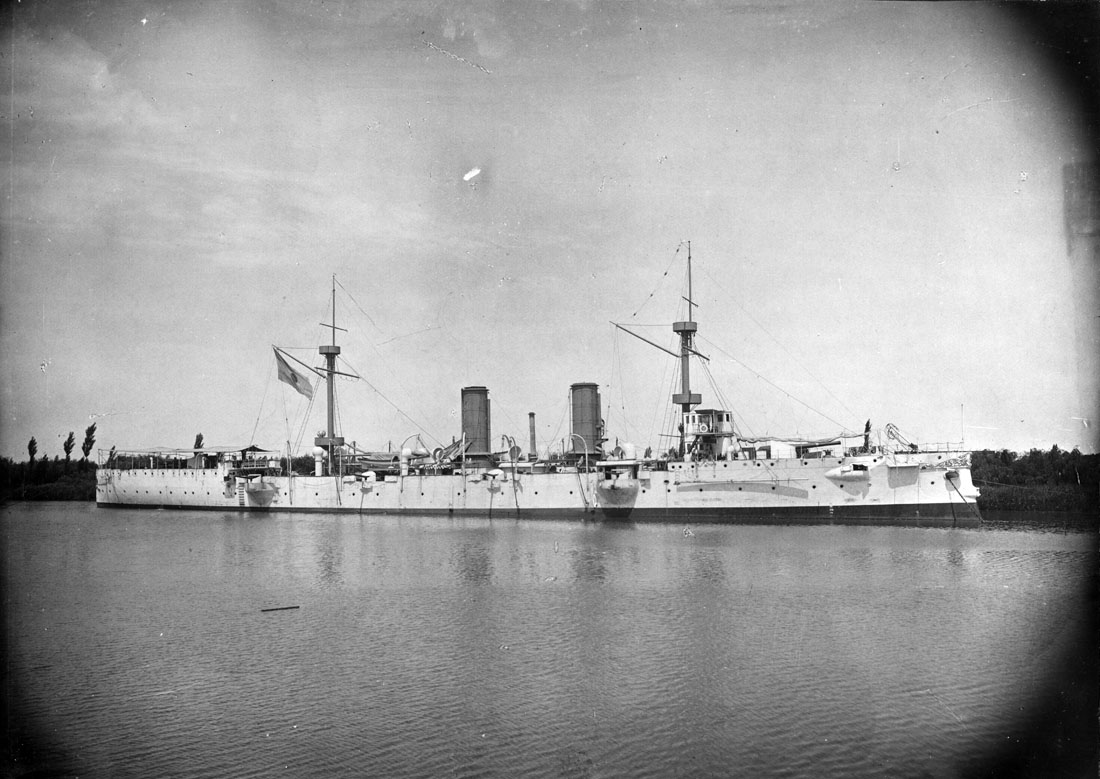
 Latest Facebook Entry -
Latest Facebook Entry -  X(Tweeter) Naval Encyclopedia's deck archive
X(Tweeter) Naval Encyclopedia's deck archive Instagram (@navalencyc)
Instagram (@navalencyc)





 French Navy
French Navy Royal Navy
Royal Navy Russian Navy
Russian Navy Armada Espanola
Armada Espanola Austrian Navy
Austrian Navy K.u.K. Kriegsmarine
K.u.K. Kriegsmarine Dansk Marine
Dansk Marine Nautiko Hellenon
Nautiko Hellenon Koninklije Marine 1870
Koninklije Marine 1870 Marinha do Brasil
Marinha do Brasil Osmanlı Donanması
Osmanlı Donanması Marina Do Peru
Marina Do Peru Marinha do Portugal
Marinha do Portugal Regia Marina 1870
Regia Marina 1870 Nihhon Kaigun 1870
Nihhon Kaigun 1870 Preußische Marine 1870
Preußische Marine 1870 Russkiy Flot 1870
Russkiy Flot 1870 Svenska marinen
Svenska marinen Søværnet
Søværnet Union Navy
Union Navy Confederate Navy
Confederate Navy Armada de Argentina
Armada de Argentina Imperial Chinese Navy
Imperial Chinese Navy Marinha do Portugal
Marinha do Portugal Mexico
Mexico Kaiserliche Marine
Kaiserliche Marine 1898 US Navy
1898 US Navy Sovietskiy Flot
Sovietskiy Flot Royal Canadian Navy
Royal Canadian Navy Royal Australian Navy
Royal Australian Navy RNZN Fleet
RNZN Fleet Chinese Navy 1937
Chinese Navy 1937 Kriegsmarine
Kriegsmarine Chilean Navy
Chilean Navy Danish Navy
Danish Navy Finnish Navy
Finnish Navy Hellenic Navy
Hellenic Navy Polish Navy
Polish Navy Romanian Navy
Romanian Navy Turkish Navy
Turkish Navy Royal Yugoslav Navy
Royal Yugoslav Navy Royal Thai Navy
Royal Thai Navy Minor Navies
Minor Navies Albania
Albania Austria
Austria Belgium
Belgium Columbia
Columbia Costa Rica
Costa Rica Cuba
Cuba Czechoslovakia
Czechoslovakia Dominican Republic
Dominican Republic Haiti
Haiti Hungary
Hungary Honduras
Honduras Estonia
Estonia Iceland
Iceland Eire
Eire Equador
Equador Iran
Iran Iraq
Iraq Latvia
Latvia Liberia
Liberia Lithuania
Lithuania Mandchukuo
Mandchukuo Morocco
Morocco Nicaragua
Nicaragua Persia
Persia San Salvador
San Salvador Sarawak
Sarawak Uruguay
Uruguay Venezuela
Venezuela Zanzibar
Zanzibar Warsaw Pact Navies
Warsaw Pact Navies Bulgaria
Bulgaria Hungary
Hungary

 Bundesmarine
Bundesmarine Dutch Navy
Dutch Navy Hellenic Navy
Hellenic Navy Marina Militare
Marina Militare Yugoslav Navy
Yugoslav Navy Chinese Navy
Chinese Navy Indian Navy
Indian Navy Indonesian Navy
Indonesian Navy JMSDF
JMSDF North Korean Navy
North Korean Navy Pakistani Navy
Pakistani Navy Philippines Navy
Philippines Navy ROKN
ROKN Rep. of Singapore Navy
Rep. of Singapore Navy Taiwanese Navy
Taiwanese Navy IDF Navy
IDF Navy Saudi Navy
Saudi Navy Royal New Zealand Navy
Royal New Zealand Navy Egyptian Navy
Egyptian Navy South African Navy
South African Navy






























 Ukrainian Navy
Ukrainian Navy dbodesign
dbodesign